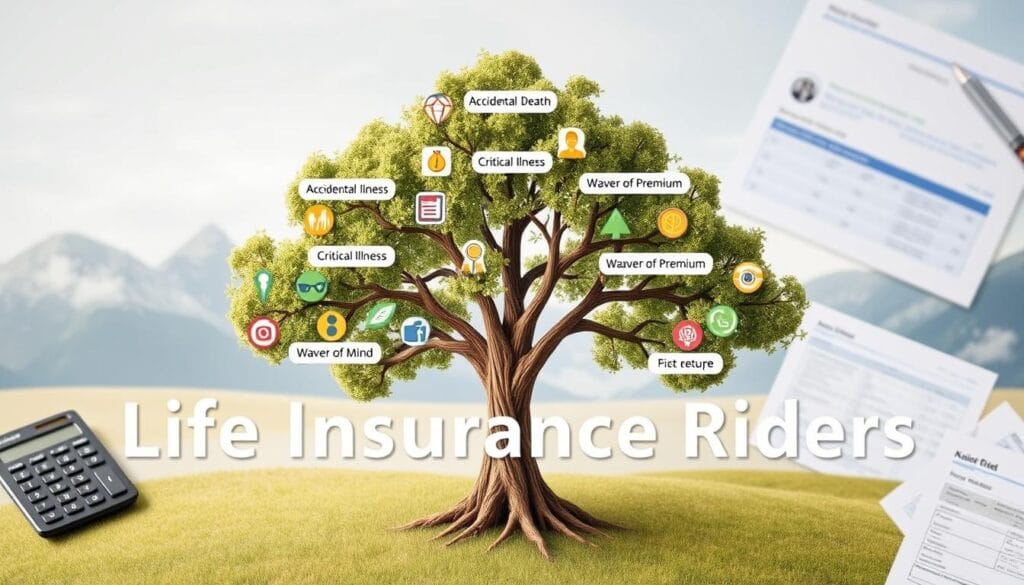Ever thought about how your family would manage financially if you weren’t around? Life insurance is a key financial safety net. Yet, many Americans are unsure about their options.
Life insurance tips are vital for protecting your loved ones. Even though 60% of people say they have life insurance, many don’t know what they have. The 2020 LIMRA study found that cost misunderstandings stop many from getting the protection they need.
Finding the right life insurance can feel like a big task. But, with the right advice, you can ensure your family’s financial future. Knowing the details of coverage helps you make informed choices. This brings peace of mind and financial security.
Key Takeaways
- Understand the true cost of life insurance is often lower than perceived
- Consider your specific financial needs and dependents
- Review policy options beyond employer-provided coverage
- Assess possible future financial obligations
- Regularly update your life insurance strategy
Understanding the Basics of Life Insurance Protection
Life insurance is a key financial safety net for families in the U.S. With about 50% of Americans having it, knowing the basics is vital for good financial planning.
Life insurance gives financial support to loved ones after the policyholder dies. Its main goal is to keep families financially stable during tough times.
Types of Life Insurance Coverage
There are two main types of life insurance:
- Term Life Insurance: Covers you for a set time (10-30 years)
- Permanent Life Insurance: Lasts your whole life and has a cash value part
About 41% of people choose term life insurance. It has lower initial costs and simple protection.
Key Policy Components
Knowing life insurance basics means understanding key parts:
- Death Benefit: The main payment to your loved ones
- Premiums: Regular payments to keep the policy active
- Cash Value: Money that grows in permanent policies
“Knowing life insurance basics helps people make smart financial choices.”
Insurance Terms and Definitions
Getting to know life insurance terms is important. It helps you understand things like level term policies. These keep the death benefit the same over time.
The average death benefit is $168,000. This gives families a big financial safety net. Also, about 75% of people think they need more coverage than they have.
Assessing Your Current Financial Situation
Creating a life insurance buying guide begins with checking your finances. Knowing your financial health helps you choose the right life insurance. Experts say you should review your finances yearly to keep your coverage up to date.
“Your financial situation is the foundation of effective life insurance planning.” – Financial Advisor Insight
When looking at your finances, keep these tips in mind:
- Create a list of what you own and owe
- Figure out your yearly income and expenses
- Look at your debts and payments
- Think about your future financial goals
Looking at your finances in a smart way means checking different parts of your money life. The Millionaire U suggests watching these important money signs:
| Financial Aspect | Recommended Target |
|---|---|
| Emergency Fund | 3-6 months of living expenses |
| Retirement Savings | 10-20% of pretax income |
| Debt-to-Income Ratio | Below 36% |
Tip: Life events like marriage, childbirth, or career changes can significantly impact your insurance needs. Always reassess your financial protection strategy during these transitions.
Life Insurance Tips for Smart Coverage Decisions
Life insurance can be complex. You need good tips to pick the right coverage for your money situation.
It’s key to understand life insurance to protect your family’s money. About 70% of Americans don’t have enough life insurance. This shows how important it is to make smart choices.
Evaluating Coverage Needs
Think about these when figuring out how much life insurance you need:
- How much you make each year
- Any debts you have
- Money you’ll need in the future
- What your dependents will need long-term
“Choosing the right life insurance is not about price, but about giving your loved ones the best protection.”
Premium Payment Strategies
| Payment Method | Potential Savings |
|---|---|
| Annual Payment | 10-20% less in premiums |
| Quarterly Payment | 5-10% savings possible |
| Monthly Payment | Standard rates |
Policy Comparison Methods
When looking at life insurance policies, consider:
- How much coverage you get
- The cost of premiums
- How flexible the policy is
- Any extra riders
Pro tip: About 61% of people look at quotes from different companies before deciding. This helps you find the best coverage for you.
Determining the Right Time to Purchase Insurance
Knowing when to buy life insurance is key for good financial planning. Life insurance tips say the best time is when you’re young and healthy. This way, you get lower premium rates and better long-term financial protection.
“The earlier you purchase life insurance, the more you can potentially save over your lifetime.”
Several life events make you need life insurance:
- Getting married
- Purchasing a home
- Having children
- Starting a business
Best practices suggest checking your coverage needs at these times. Premiums go up a lot as you get older. So, buying early is smart for your wallet.
| Age Group | Average Premium Cost | Insurability Factor |
|---|---|---|
| 20-30 years | Lowest rates | Highest |
| 40-50 years | Moderate rates | Moderate |
| 60-70 years | Highest rates | Limited |
Insurability changes with age and health. Buying insurance when you’re healthy means better rates and more protection for your family.
Calculating Adequate Coverage Amounts
Finding the right life insurance coverage is key to financial planning. Choosing the right tips can secure your family’s future with smart calculations. Knowing your financial situation is essential for a strong protection plan.
Experts offer various ways to figure out coverage amounts. They advise using detailed strategies, not just multiplying income.
Income Replacement Guidelines
Income replacement needs careful thought:
- Multiply annual income by 10-15 times
- Think about future earnings
- Include inflation and lifestyle costs
Debt and Expenses Assessment
Assessing debts and expenses is vital:
| Debt Type | Average Amount | Coverage Recommendation |
|---|---|---|
| Mortgage | $200,000 | Full payoff coverage |
| Student Loans | $37,000 | Complete debt elimination |
| Car Loans | $4,000 | Total debt settlement |
Future Financial Obligations
Think about future costs:
- Children’s education
- Potential healthcare
- Retirement savings
Experts say to cover at least 10 years of salary for long-term stability.
Financial advisors suggest updating your coverage as your life changes.
Term vs. Permanent Life Insurance Options
Choosing the right life insurance policy is a big financial decision. It’s important to know the difference between term and permanent life insurance. This knowledge helps you make a smart choice in your life insurance buying guide.

Term life insurance protects you for a set time, like 10, 20, or 30 years. It’s simple and cheaper, great for those watching their budget and needing short-term protection.
“About 60% of Americans choose term life insurance because it’s affordable and easy to understand.”
Permanent life insurance, on the other hand, covers you for life and offers extra benefits. It comes in two main types:
- Whole Life Insurance: Has fixed payments and grows in value over time
- Universal Life Insurance: Allows flexible payments and can grow through investments
| Feature | Term Life Insurance | Permanent Life Insurance |
|---|---|---|
| Coverage Duration | 10-30 years | Entire lifetime |
| Average Annual Premium | $500 (30-year-old male) | $3,000 |
| Cash Value | No cash accumulation | Tax-deferred growth |
Choosing between term and permanent life insurance depends on your financial goals, age, and budget. Young families might pick term life for its affordability. Those planning for the long term might choose permanent life insurance.
Factors Affecting Life Insurance Premium Rates
Understanding life insurance pricing is key for those looking for expert tips. Premium rates are not random. They are based on several risk factors that insurers look at.
To find the best life insurance, knowing what affects your policy’s cost is important. Insurance companies look at different things to figure out your risk level and what you’ll pay.
Age and Health Considerations
Age is a big factor in life insurance costs. Every year you get older, your premiums go up by 8% to 10%. Young people usually pay less because they are seen as less risky.
- Non-smokers get better rates
- Those with no health issues get preferred rates
- Medical tests help insurers understand your health risks
Lifestyle Impact on Rates
Your lifestyle choices greatly affect your insurance costs. Activities like racing cars or skydiving can make your rates go up. Insurers look at your habits to see if they might harm your health later.
“Your lifestyle is a direct reflection of your insurability” – Insurance Industry Expert
Occupation Risk Factors
Your job can also change how much you pay for life insurance. Jobs that are risky or expose you to dangers usually cost more.
- Jobs with chemical exposure
- Jobs that are physically demanding
- Jobs that are very stressful
Knowing these important factors can help you make better choices about your life insurance. You might even save money by planning ahead and living a healthy lifestyle.
Selecting and Managing Policy Beneficiaries
Choosing the right beneficiaries is key in life insurance planning. Every year, millions of dollars in death benefits go unclaimed. This is because many people don’t know about their life insurance policies.
When picking beneficiaries, consider a few important things:
- Know the difference between primary and contingent beneficiaries
- Be specific with percentages for multiple beneficiaries
- Think about legal and tax issues
- Update after big life changes
“Reviewing your life insurance beneficiaries is as important as purchasing the policy itself.” – National Association of Insurance Commissioners
Life insurance tips say to think carefully about your choices. About 70% of people forget to update their beneficiaries after big life events. This can cause death benefits to go to the wrong people.
Important things to think about when choosing beneficiaries include:
- Make sure they have an insurable interest
- Think about tax effects
- Plan for guardianship of minor children
- Give policy details to your beneficiaries
The NAIC says to check your policy every year. They also have a Life Insurance Policy Locator (LPL) tool. It helps find unclaimed benefits, solving problems for many people.
Understanding Policy Riders and Additional Benefits
Life insurance tips often talk about the need to customize your policy with riders. These extra features can greatly improve your coverage and flexibility. They help tailor your policy to fit your financial needs.

Policy riders are special features you can add to your life insurance. They offer extra protection or benefits. Smart life insurance advice suggests carefully looking at these options to get the most from your policy.
Exploring Common Rider Types
- Waiver of Premium Rider: Suspends premium payments if the insured becomes disabled
- Accelerated Death Benefit Rider: Allows accessing a portion of death benefits during terminal illness
- Guaranteed Insurability Rider: Enables increasing coverage without medical exams
- Long-Term Care Rider: Provides reimbursement for qualifying care expenses
Cost vs. Value Analysis
Choosing the right riders means weighing their benefits against their costs. Some riders offer great value, while others might not be worth the price.
| Rider Type | Average Cost | Potential Benefit |
|---|---|---|
| Waiver of Premium | 1-2% of base premium | Continues policy during disability |
| Accelerated Death Benefit | Often included at no extra cost | Access funds during terminal illness |
| Guaranteed Insurability | 3-5% of base premium | Increase coverage without medical underwriting |
“Not all riders are created equal. Carefully evaluate each option’s impact on your financial protection.”
Life insurance tips recommend talking to a professional agent to find the right riders for you. The right mix of riders can offer the protection you need, tailored to your life situation.
Regular Policy Review and Updates
Keeping your life insurance up to date is key. It’s important to review your policy regularly. This ensures it covers you as your life changes. Experts say to check your policy at least once a year or after big life events.
Life insurance tips tell us to watch for big changes in our lives. These changes can affect how much coverage we need. Some examples include:
- Marriage or divorce
- Birth of children
- Career changes
- Purchasing a new home
- Significant increases in income
Managing your policy well can help avoid financial gaps. It ensures your family stays protected.
“Your life insurance policy should grow and adapt with you, just like any critical financial instrument.” – Financial Planning Expert
When you review your policy, look at a few important things:
| Review Area | Key Considerations |
|---|---|
| Coverage Amount | Check if your coverage meets your current financial needs |
| Beneficiary Designations | Make sure your beneficiaries match your current family |
| Policy Type | Determine if term or permanent insurance fits your needs now |
| Premium Affordability | See if your premiums fit within your budget |
By following these tips and best practices, you can keep a strong financial safety net. It will grow with you as your life changes.
Working with Insurance Providers and Agents
Getting into life insurance means working with experts. Finding a good agent is key to understanding policy options.
Good agents make complex policies easy to understand. Researching insurance providers helps find a reliable agent who knows your financial situation.
“The right insurance agent transforms complicated coverage choices into personalized financial protection.”
- Verify agent credentials and professional certifications
- Request detailed policy comparisons
- Discuss your financial goals openly
- Know about commission structures and possible biases
When talking to agents, have a list of questions. Ask about coverage, premiums, and long-term effects. Good communication leads to the best insurance plan for you.
| Agent Type | Advantages | Considerations |
|---|---|---|
| Captive Agents | Single company representation | Limited product portfolio |
| Independent Agents | Multiple insurance options | Higher chance for custom solutions |
A good agent puts your financial safety first, not just making a sale. They help you find life insurance that protects your family and fits your budget.
Conclusion
Life insurance is key to protecting your finances. Recent numbers show 39% of people plan to buy life insurance soon. Also, 44% of Gen Z is looking into it. This shows more people see life insurance as important for their families.
Using good life insurance tips can really help with financial security. Studies say 59% of parents know life insurance is important. But, 47% think their coverage isn’t enough. This shows we all need to plan our life insurance better.
Finding the right insurance can be tough. You need to think about different types, how much coverage, and your money situation. Choosing between term and permanent policies is important. It’s about protecting your family’s future, not just spending money.
This guide helps you make smart life insurance choices. It’s about planning for different life stages and money needs. With the right advice and a proactive approach, you can build a strong financial safety net. This gives you peace of mind and protection for years to come.

